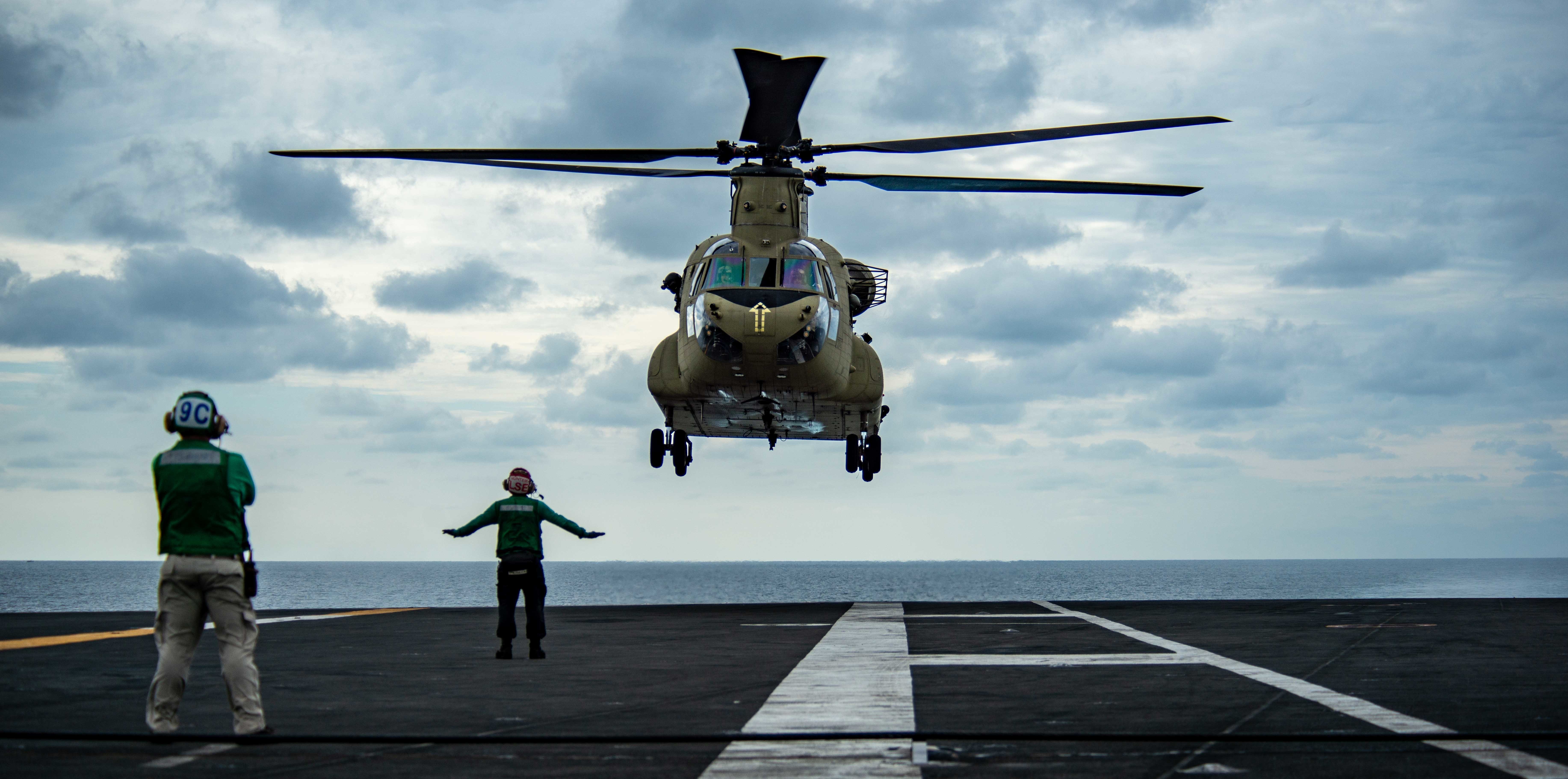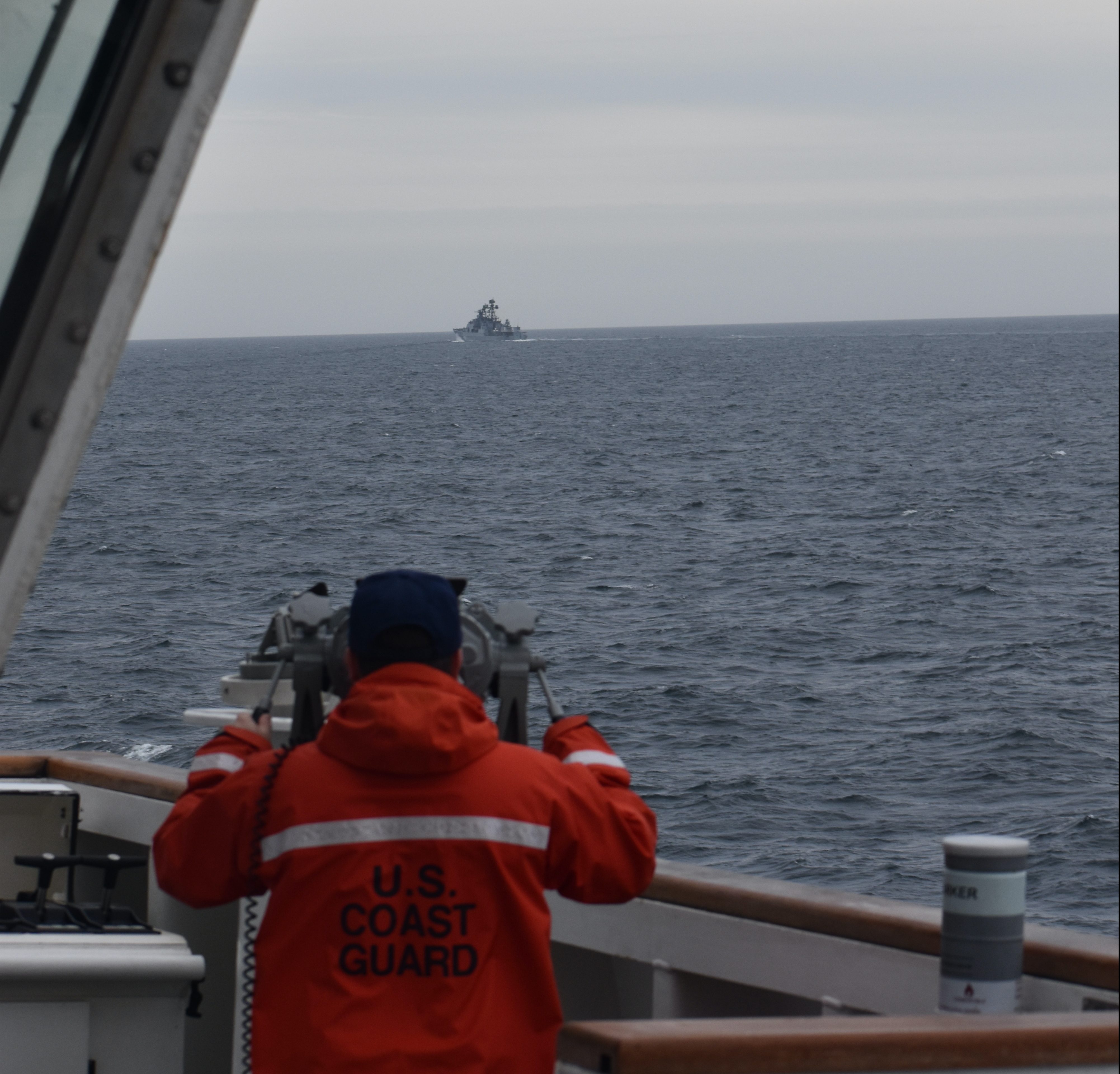
The Ronald Reagan Carrier Strike Group (CSG) began drills with the Republic of Korea Navy in the East Sea on Monday, the U.S. Navy announced.
The Maritime Counter-Special Operations Exercise (MCSOFEX) in the East Sea with the ROKN, through Thursday, the service said. U.S. Navy units participating in the exercise are carrier USS Ronald Reagan (CVN-76) with embarked Carrier Air Wing (CVW) Five, cruiser USS Chancellorsville (CG-62), destroyers USS Barry (DDG-52) and USS Benfold (DDG-65) and staff from Destroyer Squadron (DESRON) 15 and Carrier Strike Group (CSG) Five, according to the release. The Army’s 2nd Combat Air Brigade and U.S. Air Force’s 7th Air Force joined with units from U.S. Special Operations Command Korea for the exercises.
“Our combined ROK-U.S. naval force is demonstrating its strength and resolve by conducting this exercise together to build our combat readiness,” said Rear Adm. Michael Donnelly, commander, Task Force (CTF) 70/CSG 5, in the release.
The bilateral exercise includes live fire, surface warfare, anti-submarine and anti-air drills.
“This exercise will improve ROK-U.S. combined operational capabilities and bolstered interoperability,” said Rear Adm. Kwak, Kwang Sub, commander, ROK Navy Maritime Battle Group (MBG) 1, in the release. “Two navies will continue to maintaining combined naval defense posture based on iron-clad ROK-U.S. alliance.”
Russia, Chinese Warships Spotted near Alaska

On Monday, the U.S Coast Guard issued a release stating that the joint Russian Navy – People’s Liberation Army Navy Surface Action group was sighted sailing approximately 75 nautical miles north of Kiska Island, Alaska, on Sept. 19.
According to the release, USCGC Kimball (WMSL-756) was on a routine patrol that day when it encountered a PLAN cruiser with the pennant number 101, which corresponds to CNS Nanchang (101) though China considers the ship as a destroyer.
Kimball later identified two more Chinese naval vessels and four Russian naval vessels, including a Russian Navy destroyer, all in a single formation with Nanchang as a combined surface action group operating in the U.S. Exclusive Economic Zone (EEZ), according to the release.
As a result of the sighting, Kimball is now operating under Operation Frontier Sentinel, a Seventeenth Coast Guard District operation designed to meet presence with presence when strategic competitors operate in and around U.S. waters.
“The U.S. Coast Guard’s presence strengthens the international rules-based order and promotes the conduct of operations in a manner that follows international norms. While the surface action group was temporary in nature, and Kimball observed it disperse, the Kimball will continue to monitor activities in the U.S. EEZ to ensure the safety of U.S. vessels and international commerce in the area,” according to the release, which also added that a Coast Guard Air Station Kodiak C-130 Hercules air crew provided support to the Kimball’s Operation Frontier Sentinel activities.
Coast Guard cutters deployed to the Bering Sea and North Pacific Ocean also encountered Chinese naval vessels, including a surface action group transiting approximately 50 miles off the Aleutian Island chain, in September 2021.
“While the formation has operated in accordance with international rules and norms,” said Rear Adm. Nathan Moore, Seventeenth Coast Guard District commander in the release, “we will meet presence-with-presence to ensure there are no disruptions to U.S. interests in the maritime environment around Alaska.”
The Russian Navy – PLAN surface action group consists of Russian Navy destroyer RFS Marshal Shaposhnikov (543), corvettes RFS Sovershennyy (333), RFS Gromkiy (335) and RFS Hero of the Russian Federation Aldar Tsydenzhapov (339), and replenishment ship Pechanga, while the PLAN contingent consist of Nanchang, frigate CNS Yancheng (546) and replenishment ship CNS Dongpinghu (902).
The two navies have been working together to carry out a joint naval patrol in the Pacific Ocean, the Russian Defense Ministry announced Sept. 15.
On Friday, the Russian Defense Ministry issued a statement saying that the group had held a number of drills, including search and rescue rehearsals and air defense exercises, as part of joint patrols in the Pacific Ocean.
The statement also said the group had been practicing maneuvers using various formations and establishing communication links between the vessels and that several joint and individual exercises were conducted to work out anti-submarine missions, search and rescue operations at sea and execute air defense tasks, with flights performed by antisubmarine and rescue ship-based helicopters.
The Russian and Chinese warships have sailed more than 3,000 nautical miles in the past 12 days and are continuing their patrols, according to the release.
PLAN ships have also been sighted transiting through Japanese straits, according to Japan Ministry of Defense releases.
On Monday, the Joint Staff Office (JSO) of the Ministry of Defence issued two releases with the first release stating that at around 8 a.m. Friday, a PLAN destroyer, frigate and replenishment ship were sighted sailing southeast in an area 180km north of Miyako Island before they sailed southeast through the Miyako Strait ,which lies between Miyako Island and Okinawa. The PLAN ships were identified as destroyer CNS Huainan (123), frigate CNS Rizhao (598) and replenishment ship CNS Kekexilihu (968).
The three ships form the PLAN 42nd China Naval Escort Task Force, which left their homeport on Sept. 21 for the Gulf of Aden to conduct anti-piracy escort missions there. The task force is now in the South China Sea, according to a release from China’s Ministry of National Defense.
Look who is visiting Yokosuka 🇯🇵 https://t.co/B29o4Vr2n3
— U.S. Pacific Fleet (@USPacificFleet) September 27, 2022
The JSO release stated that the PLAN ships were monitored by Japan Maritime Self Defense Force (JMSDF) destroyer JS Inazuma (DD-105) and minesweeper JS Shishijima (MSC-691), a JMSDF P-1 Maritime Patrol Aircraft (MPA) of Fleet Air Wing 1 based at JMSDF Kanoya Air Field, Kyushu, and a P-3C Orion of Fleet Air Wing 5 based at Naha Air Base, Okinawa.
The second JSO release stated that at noon Friday, a PLAN Dongdiao class surveillance vessel, hull number 796, was sighted sailing east in an area 100 km southwest of Tsushima, Nagasaki Prefecture, and subsequently sailed northeast through the Tsushima Strait in the Sea of Japan.
Minesweepers JS Toyoshima (MSC-685) and JS Ukushima (MSC-686) and fast attack craft JS Umitaka (PG-828) shadowed the PLAN ship.
The JSO issued another release Tuesday after a PLAN Dongdiao class surveillance vessel with the hull number 794 was sighted around 4 p.m. Monday sailing northwest in an area 140km east of Miyako Island. The ship then sailed northwest through the Miyako Strait and into the East China Sea.
Dongdiao 794 previously sailed southeast through the Miyako Strait on Aug. 28, and Toyoshima and a JMSDF P-3C Orion of Fleet Air Wing 5 shadowed the PLAN ship.
Over in Yokosuka, destroyer USS Zumwalt (DDG-1000) and LCS USS Oakland (LCS-24) arrived at Commander, Fleet Activities Yokosuka (CFAY) on Monday for scheduled port visits.





